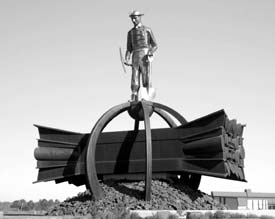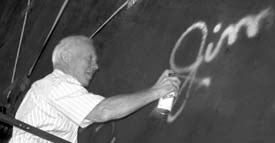 |
|
Notes from Underground by Judy Jackson
Neutrinos fly through the earth with the greatest of ease. In the blink of eye,
they flit effortlessly through the planet’s rocky crust at nearly the speed of
light. Not so for the miners of generations past who dug their way, foot by
backbreaking, dangerous foot, through the rock of Minnesota’s Iron Range.
Congressman James Oberstar, who represents Minnesota’s 8th district, home
of the MINOS far detector, recalled his father’s 26 years in the mines, where
miners spent all day working in “drifts,” or underground tunnels, so cramped
the men could not stand up straight.
“It was not always pleasant underground,” Oberstar said in his remarks at
the ceremony, “and it was fraught with danger. In the Milford Mine disaster
of 1924, thirty-four men lost their lives. My father told me that for a miner the
most unforgettable sound was the screams of men from the cage when the
cable broke and there was nothing they could do and no place to go. The
neutrinos will have an easier trip.”
The image resonated with visitors who had only
recently completed their own spine-tingling halfmile
journey in Soudan’s “cage,” the historic mine
elevator that takes people and equipment from the
surface to Level 27, the site of the spacious
MINOS cavern.
Some 160 scientists, government officials,
university staff members, contractors and guests
assembled in the MINOS cavern to dedicate the
experiment’s detector, an array of eight-meter
octagons of steel and plastic scintillator that will
search for interactions of the fundamental particles
known as neutrinos. To date, workers have
completed the installation of the detector’s first
“supermodule,” comprising 248 of the detector’s
ultimate 486 layers.
Oberstar, now serving his fourteenth Congressional
term, described to the audience the value miners
put on education.
“Theirs was a hard life, to achieve a better life for
their children,” Oberstar said. “It was a guiding
principle that their own children would receive an
education. As I was finishing high school, my father
sat me down and said ‘Son, you have two choices.
You can go to college or you can go into the mine.
And I don’t want any kid of mine working
underground.’”
University of Minnesota Regent Anthony Baraga
grew up with Oberstar in the mining town of
Chisholm, Minnesota. Baraga, also the son
of a miner, described his own brief experience
underground.
“As I came down in the lift today,” Baraga said,
“I was reminded of the day when, as a young man,
I took another lift deep into a Minnesota iron mine.
I spent the day working in the drift, with the other
miners. At the end of the day, I took the lift back up.
After I showered, my father met me and asked me
how it went. I said it went fine. ‘But there’s just one
thing,” I told my father. “I am never going back
down there again. I don’t care if it means I can’t
go to college. I don’t care what it means. I will
never work underground again.”
Baraga reminded the audience of the connection
between those who dug the deep caverns of
Minnesota mines and the physicists who now
use those mines for their experiments. Physicists
place particle detectors in deep mines in order to
use the earth’s crust to shield the detectors from
the bombardment of cosmic rays at the earth’s
surface, which would create undesirable “noise”
in the experiment.
“It is fitting for us to remember the generations of
miners who made this possible,” Baraga said.“In a
very real sense, we are the heirs of those miners.”
The Soudan Mine closed for mining operations in
1962. Both Oberstar and Baraga welcomed the
new use of the mine for physics research.
“This mine was once dedicated to the pursuit of
iron ore so pure you could weld two pieces of
it together,” Oberstar said. “Now this mine is
dedicated to the pursuit of pure knowledge.”
The congressman, whose 26,000-square-mile
district, the largest east of the Mississippi, includes
many descendants of miners who immigrated to
Minnesota from foreign nations, noted the
international character of both mine crews and
scientific collaborations.
Other speakers at the dedication included
Fermilab Director Michael Witherell, Stanford
University physicist and MINOS spokesman
Stanley Wojcicki, Laura Bautz of the National
Science Foundation, and Commissioner Allen
Garber of the Minnesota Department of Natural
Resources, which administers the Soudan Mine
as a Minnesota state park and a National Historic
Landmark. Daily tours give visitors a look at both
early mining operations and, now, physics
experiments.
Commissioner Garber described the Soudan
Mine as an extraordinary piece of the past and
a reminder of the contributions of the miners in
establishing Minnesota
“As commissioner of the Department of Natural
Resources,” Garber said, “I have attended many
state park dedications. I can tell you that I have
never attended one more unique than this one.”
Cover photo:
Let the oscillations begin!
The ribbon cutting ceremony
was a highlight at the
MINOS dedication.
Performing the task
(from left to right): physicist
Earl Peterson, University of
Minnesota; Anthony Baraga,
Regent of the University of
Minnesota; Allen Garber,
Minnesota Department of
Natural Resources; Fermilab
Director Michael Witherell;
Congressman James
Oberstar; Stan Wojcicki,
Stanford University and
spokesperson of the MINOS
experiment; and Laura
Bautz, National Science
Foundation.
On the Web:
|
 It was a contrast that emerged vividly in the dedication ceremonies for the
MINOS neutrino detector, held July 2, half a mile underground in a cavern
of Minnesota’s oldest and deepest iron mine in Soudan, Minnesota. Two
Minnesota miners’ sons reminded the audience at the event of the debt
neutrino scientists owe to the men who spent their lives in the underground
in search of iron ore.
It was a contrast that emerged vividly in the dedication ceremonies for the
MINOS neutrino detector, held July 2, half a mile underground in a cavern
of Minnesota’s oldest and deepest iron mine in Soudan, Minnesota. Two
Minnesota miners’ sons reminded the audience at the event of the debt
neutrino scientists owe to the men who spent their lives in the underground
in search of iron ore.
 The underground laboratory, which also houses
the Soudan 2 nucleon-decay experiment and the
Cryogenic Dark Matter Search, is managed by the
University of Minnesota.
The underground laboratory, which also houses
the Soudan 2 nucleon-decay experiment and the
Cryogenic Dark Matter Search, is managed by the
University of Minnesota.
 “It is appropriate,” Oberstar said, “that where
miners of many nations came to mine the deepest
reserves of iron ore, now scientists of many nations
come together to pursue the deepest origins of the
universe. Miners once thought it was impossible
to extract ore from deposits so deep in the earth.
And it was once thought impossible to discover
the neutrino. It took many years, but we have
been able to do it.”
“It is appropriate,” Oberstar said, “that where
miners of many nations came to mine the deepest
reserves of iron ore, now scientists of many nations
come together to pursue the deepest origins of the
universe. Miners once thought it was impossible
to extract ore from deposits so deep in the earth.
And it was once thought impossible to discover
the neutrino. It took many years, but we have
been able to do it.”
 as the nation’s leading
ore-producing state. He applauded the development
of an underground laboratory as a new
chapter in Soudan’s history.
as the nation’s leading
ore-producing state. He applauded the development
of an underground laboratory as a new
chapter in Soudan’s history.